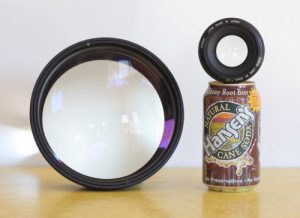The faint diesel rumble, pitter-patter of delivery-man-sized feet, and thud of corrugated on concrete? They could mean only one thing: my order from the Surplus Shed had arrived. Aflutter, I tore to the front porch, shredded the box like a Kindergartner on Christmas morning, and, out of the scraps, hoisted my new lens towards the heavens!
You know the angelic “ahhhhhhh” chorus sound that plays whenever someone “sees the light” in the movies? It rose to a crescendo in the background.
Because, like a first kiss, nothing can completely prepare a photographer for his or her initial encounter with a gigantic disc of aluminum and precision-ground optical glass:

A New Lens!
That’s all 5.3 pounds of it, standing on edge, seven inches across and two inches deep, next to a twelve-ounce soda can and a Canon 50mm f/1.4 lens for the sake of scale. Oooooh, baby.
Side View
Owing to its pancake shape – the opposite of the typical long-and-slender lens – it soon became known as the Glass Frisbee.
I bought the Frisbee for its incredible combination of 200mm focal length and f/1.3 aperture, which I’ll use to push the limits of narrow depth of field. By the laws of physics, once shoehorned onto my large-format 4×5 monorail camera, it’s the optical equivalent of a 50mm f/0.35 lens on a full-frame SLR. From there, I begin an epic journey into a dreamy portrait-esque frontier, with triple the background blur of any currently-available off-the-shelf photographic system! All theoretically, at this point, of course.
In the meantime, the Frisbee will help with a handful of other projects. When I’m feeling Evil, it’ll focus the Death Ray. My respectable, gentlemanly side shall enjoy a Cyclopean monocle of remarkable refinement. And, should the situation become particularly funky, as it does from time to time, well, damn yo, the Frisbee’s got it covered.